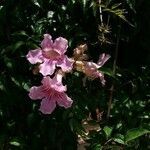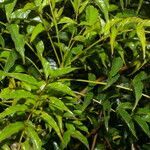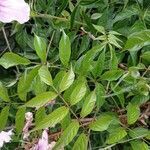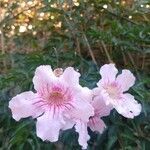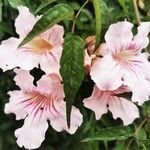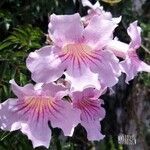Vine or subscandent shrub. Leaves imparipinnately compound, usually 7-9 foliolate, without tendrils, the leaflets more or less ovate, obtuse to short-acuminate, serrate, truncate to cuneate or somewhat attenuate, 2.5-3.8 cm long and. 1.5-2.0 cm wide, petiolulate. Inflorescence a terminal panicle. Flowers with the calyx large, cupular-campanulate, 1.5-2 cm long, strongly 5-dentate with apiculate lobes, pale lavender when fresh; corolla pale lavender or pinkish with a magenta patch at the base of the 2 adaxial lobes, the tube white with deep magenta lines inside and some pinkish splotches near the base, cam-panulate above a short cylindric base, 6-8 cm long, with scattered lepidote scales on the lobes, glandular-pubescent at the level of stamen insertion inside and pubescent with kinky trichomes in the sinuses between lobes, otherwise glabrous; stamens didynamous, the thecae divaricate, 3 mm long, the longer filaments 1.9-2.0 cm long, shorter filaments 1.4-1.5 cm long, the staminode 3 mm long, inserted ca. 10 mm from base of corolla tube; pistil 3.2-3.4 cm long, the ovary linear, glabrous, 5 mm long and 1.5 mm wide, the ovules 6-seriate in each locule; disc pulvinate, 0.5 mm long and 1.5-2.0 mm wide. Capsule (Sprague) linear and leathery.
Vigorous, evergreen, glabrous liane. Leaflets (5)-7-9, 2-7 × 1-3 cm (larger on strong vegetative shoots), usually lanceolate-ovate, sometimes ovate to broadly oblong-elliptic, serrate, becoming serrulate towards infl.; base cuneate, rounded, truncate, often asymmetric; apex short-to long-acuminate; petiolule to 1 cm long. Panicle many-flowered; peduncles and pedicels purplish. Calyx 1.2-1.8-(2) cm long, pinkish; teeth 4-7 mm long, triangular; apiculus c. 1 mm long. Corolla 6-8 cm long, pink with rose-red veins, especially inside tube; limb broader than high; lobes 1.2-2 cm long, suborbicular. Filaments with numerous short-stalked yellow glands at base. Style < to slightly > longer stamen pair, 2-3 cm long. Capsule rarely formed, 16-26 cm × 5-10 mm; valves coriaceous. Seed wings nearly 1 cm wide.
Scrambler, occasional shrub; evergreen, branches terete, ribbed, glabrous with few minute scales, nodes pilose. Leaves compound, 7-9 leaflets, ovate, deep green, glabrous, lower surface gland-dotted, margins crenate. Inflorescence many-flowered panicles; rachis and pedicles glabrous. Flowers pink, scented. Calyx campanulate, glandular above, lobes deltoid-ovate, mucronate, ciliolate. Corolla funnel-shaped, 5-lobed, glabrous outside, nearly so inside. Flowering time Nov.-Apr. Fruit a long, narrow, flattened capsule. Seeds brown, ovate, flat, papery winged.
Leaflets 7-9, crenate, 2½-4 by 1-2 cm. Corolla pale lavender or pinkish, with magenta patches and lines in the mouth and tube, 6-8 cm long, in terminal thyrses.
